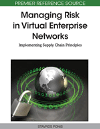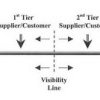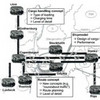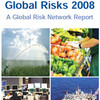 Publish or perish? Publish. It has taken its time, but finally it is there, the book that has my chapter in it. Managing Risk in Virtual Enterprise Networks: Implementing Supply Chain Principles, edited by Stavros Ponis, aims to serve as a point-of-reference for scholars and researchers who are interested in studying Risk Management in a cross-disciplinary fashion, linking Virtual Enterprise Networks with Supply Chain Management and Risk Management. I am proud to be able to contribute of this attempt at cross-fertilization between three distinctively different, yet highly interconnected fields of research.
Publish or perish? Publish. It has taken its time, but finally it is there, the book that has my chapter in it. Managing Risk in Virtual Enterprise Networks: Implementing Supply Chain Principles, edited by Stavros Ponis, aims to serve as a point-of-reference for scholars and researchers who are interested in studying Risk Management in a cross-disciplinary fashion, linking Virtual Enterprise Networks with Supply Chain Management and Risk Management. I am proud to be able to contribute of this attempt at cross-fertilization between three distinctively different, yet highly interconnected fields of research.
My proposal
It was in late 2008 that I received an email from the editor, Stavros Ponis, inviting me to submit a proposal for a book chapter for this book. At that time I had very little knowledge of virtual enterprise networks, but the more I read, the more I realized that supply chains (or supply networks) and virtual enterprise networks shared much common ground. At least the way I saw it, or rather “read” it, as my understanding of virtual enterprise networks came from these two books mainly: The Networked Enterprise by Ken Thompson and The Agile Virtual Enterprise by Ted Goranson. Armed with these two boks and a selection of supply chain risk articles I set out to propose a chapter for a theoretical framework on how to apply supply chain risk principles in a virtual enterprise network.
My chapter
Suprisingly, my chapter proposal was accepted, and now I spent some grueling months actually writing it, while learning even more more about supply chain risk, let alone virtual enterprise networks along the way. The peer review process after submission was quite interesting, too, as one reviewer said “publishable as is”, another said “needs revision” and a third said “not publishable at all”, the latter being a euphemism for “has no idea what he’s talking about”, as the review comments from this reviewer pointed to. Anyway, in the end, my chapter met the editor’s requirements and my first major publication is out there for everybody to see. I’m published now, so hopefully, I will not perish, like so many others. Initially I had the intention of presenting a short summary of the chapter on risks in virtual enterprise networks as a conference paper at MITIP 2009, but other engagements tied me up, so it never was presented, until now, when it was finally published.
My abstract
This is the abstract of my chapter, aptly titled “A Conceptual Framework for Risk and Vulnerability in Virtual Enterprise Networks”:
Is managing risks in Virtual Enterprise Networks different from managing risks in supply chains? It is not unusual for suppliers in a supply chain to come together and act as a Virtual Enterprise Network (VEN) and the supply chains of today’s globalized and outsourced business environment exhibit many VEN-like features. Looking at VEN risk management from the perspective of supply chain risk management, current ideas on VENs will serve as a base onto which ideas on supply chain risk will be transposed. Many concepts related to supply chain risk will be explored and related to their possible VEN counterparts: risk, vulnerability, robustness, flexibility, resilience and business continuity. Conceptual in its approach and drawing from other areas of research, this chapter introduces four distinct groups of VENS, namely Constrained, Directed, Limited and Free VEN, and concludes that VEN risk management can and should learn from supply chain risk management.
My appraisal
When looking at the publisher’s website, this is what the editor writes in the preface:
The first chapter of this section by Jan Husdal can very well serve as an introduction to the whole book since it attempts to bridge the gap between the concepts of Virtual Enterprise Networks and Supply Chains by building on literature findings drawn from both research areas. Jan Husdal, provides the reader with a novel perspective on VENs and in doing so a new VE taxonomy is introduced. After a fruitful discussion on risk management in both VEN and supply chains, Husdal turns to the ultimate objective of this chapter, which is to propose a conceptual framework for Risk Management in VENs with a Supply Chain Risk Management perspective and provide well argumented evidence that VEN risk management can and should learn from existing supply chain risk management initiatives.
I do feel a bit honored now, as I have the opening chapter of the book, and hopefully I will make readers want to read on after reading my introduction.
Read online
A Conceptual Framework for Risk and Vulnerability in Virtual Enterprise Networks
Download
The full paper can be downloaded from my profile at researchgate.net.
My fellow writers
Looking at the 13 other contributions, as described in the same preface, I can already now say that I look forward to reading the whole book:
- Brian Squire takes an exploratory look at the use of formal network measures to further understand the sources of risk in enterprises organized in networks.
- Burak Sari argues that trust is the shared belief that network partners can depend on each other to achieve a common goal and constitutes a critical structural and cultural characteristic that influences the network’s success and performance.
- Samir Dani proposes a risk management framework for Virtual Enterprise Networks based on innovation and the effective feed of its results back to the risk management process.
- Ettore Bolisani provides a knowledge-based view of Virtual Enterprise Networks and attempts an analysis and classification of the possible sources of risk associated to the management of knowledge in a Virtual Enterprise Network.
- Mohammad Shalan aims to provide a comprehensive in depth analysis of risks and issues associated with the IT aspects of Virtual Enterprise Networks from technical and procedural point of view and to prescribe specific guidelines to mitigate the effects of the identified and analyzed risks, processes and consequences.
- Ila Manuj presents a simulation model development process for modeling disruptions and other crises events in global virtual enterprise networks and supports her proposed methodology by providing the reader with an indicative modeling example.
- Klimov et al. present a framework of simulation-based supply chain risk analysis with a risk measurement system, based on the evaluation of supply chain performance.
- Omera Khan and Alessandro Creazza highlight the importance of keeping product design at the centre of the entire business process and managing it concurrently within the supply chain, utilizing their suggested 4C approach.
- María Jesús Sáenz, Maria Pilar Lambán and Eva Navarro introduce a conceptual framework including a set of best practices which enable flexibility value to be created in the context of an inter-organizational network.
- Stavros Ponis and Epaminondas Koronis study the knowledge-related risks of outsourcing by identifying and taxonomizing the risk sources of the outsourcing initiative, and by pinpointing the related threats and proposing mitigating actions.
- Konstantinos Kirytopoulos, Dimitra Voulgaridou and Vrassidas Leopoulos introduce a decision support framework based on the so-called ANP-BOCR model, focusing on the supplier selection process which is critical for clusters where its members not only cooperate but also compete.
- Nikolaos Panagiotou, Stylianos Oikonomitsios, Christina Athanasiadou and Sotiris Gayialis develop an elaborated toolset that supports the extended role of Internal Audit as a facilitator of change towards the network’s business objectives, thus assisting and improving business processes and enhancing the quality of the enterprise network.
- Christos Manolarakis, Ioannis Christou and Gregory Yovanof attempt to capture market dynamics and provide Virtual Enterprise Network managers with a new insight on consumer segmentation by proposing an Agent Based Modeling tool that allows the description and simulation of the evolution or interactions of social structures.
Interesting? I think so, and in due time, I will post a full review on this blog.
My conclusion
I can only agree with the editor here, who says that
Hopefully, this book including more than a thousand scientific references will establish the necessary background for further research in the field, attract interest and create challenges for both researchers and practitioners, thus initiating a broad academic discourse.
That remains to be seen, but I will certainly do my part here.
Reference
Ponis, S. (ed) (2010). Managing Risk in Virtual Enterprise Networks: Implementing Supply Chain Principles. Hershey, PA: IGI
Editor link
- ntua.gr: Stavros Ponis
Publisher link
- igi-global.com: Managing Risk in Virtual Enterprise Networks
amazon.com
- amazon.com: Managing Risk in Virtual Enterprise Networks
Related
- husdal.com: On managing risks in Virtual Enterprise Networks
- husdal.com: Understanding risks in Virtual Enterprise Networks












